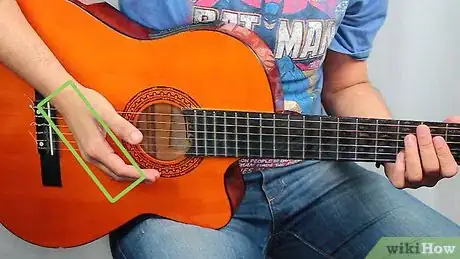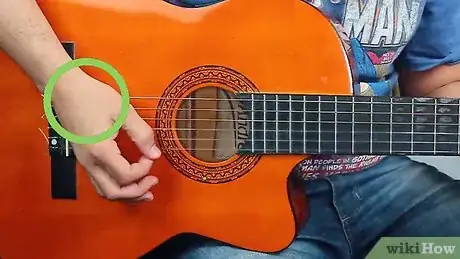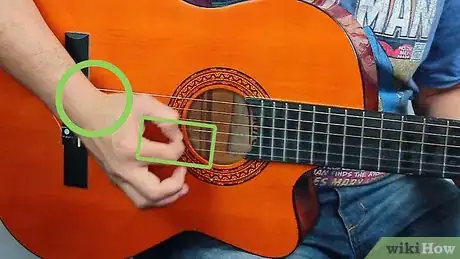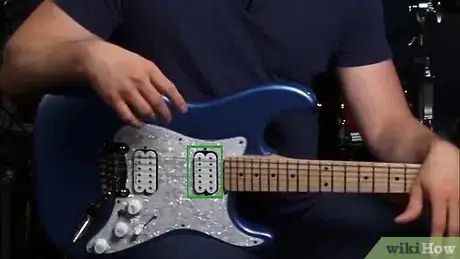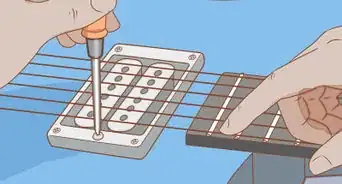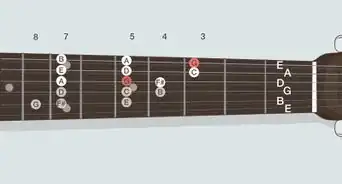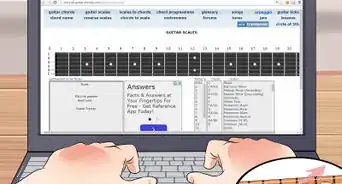This article was co-authored by Nicolas Adams. Nicolas Adams is a 5th generation musician of Serbian Gypsy descent and the lead guitarist of the band Gypsy Tribe. Based in the San Francisco Bay Area, Nicolas specializes in Rumba Flamenco and Gypsy jazz and playing the guitar, Bouzouki, Balalaika, and piano.
This article has been viewed 166,783 times.
Palm muting is a commonly used guitar-playing technique in which you use the side of your strumming hand to mute the notes being played. The purpose is to cut out extra string noise when you're playing or to stop the sound completely.[1] You can also use the technique to dampen the sound rather than mute it, depending on where you place your hand.[2]
Steps
Using Your Strumming Hand to Dampen the Sound
-
1Place the fleshy side of your palm lightly on the strings. Pretend your karate-chopping the strings. Don't actually hit them, but that shows you what part of your hand should be hitting the strings. It should be the outside of your palm.[3]
- When you first put your hand down, it should be perpendicular to the strings, not laying flat against them.
- Slide the hand back as close to the bridge as you can-- this makes it easier to learn.
-
2Keeping your palm down on the strings, strum normally. Use your fingers and light wrist movement to strum while still keeping everything muted. You want to work on keeping the same weight on the strings as you strum, moving only up and down, not against the strings, as you pick.
- It is often easiest to start by just picking one string. As you get used to keeping it palm muted, play a two-string chord, then a three, and onward.
Advertisement -
3Adjust the pressure of your palm to adjust your sound. A lot of palm muting is about the feel on the strings, since the actual skill is not very hard. The harder you press, the less you'll hear the note of the string and more you'll hear a dampened, percussive sound. If you are too light you'll just hear buzzing as the strings struggle to move. The perfect sound is a deadened, but still melodic, note that ends quickly after you strum it.[4]
- With dampening, you should be able to hear the pitch when you pick the string. Try picking the strings one at time to make sure you can hear all the proper pitches rather than a dead plucking sound.[5]
-
4Experiment with hand position. You can change how much your hand dampens the sound by moving it back and forth on the strings. Moving closer to the fretboard dampens the sound more.[6]
- However, as noted, you should keep your hand as close to the bridge as possible if you still want to hear pitch.
-
5Adjust your hands to sound certain notes. If you want the first string to sound, lift off that part of your hand. You can test to make sure it's sounding correctly by strumming it. Practice lifting off each string in order. Once you've mastered the technique, you can control which strings are dampened and which strings are not.[7]
- You'll be lifting from your wrist, rather than from your fingers. You can curl your wrist up and down to open up or mute certain strings with some practice.
Improving Your Sound
-
1Tune into the bridge pickups of your electric guitar. Since you're picking and muting near the bridge, these pickups will get the best, thickest sound for you.
- For a more distorted, buzzy sound, use the neck pickups.
-
2Use humbucker pickups whenever possible. These pickups will grab a lot of that deep, chunky tone that you want when palm muting.
-
3Work on moving in and out of palm muting mid strum. Listen to old Green Day tracks, for example. They are simple chords and structures, but the ability to go quickly from palm muted to open strings allows him to texture and layer the guitar part uniquely.
- Learn to start palm muting, then slowly raising your palm off. Become your guitars volume knob, switching fluidly.
Community Q&A
-
QuestionWhere can I buy instructional DVDs?
 Community AnswerYou could try an online retailer like Amazon or just a local music store in your area.
Community AnswerYou could try an online retailer like Amazon or just a local music store in your area. -
QuestionHow do you only mute one string?
 Community AnswerUse a finger from your left hand. Doing it with your right hand is ineffective.
Community AnswerUse a finger from your left hand. Doing it with your right hand is ineffective. -
QuestionHow do I mute only one string with my palm, as in sweep-picking?
 JustjaythingsCommunity AnswerThat's a very difficult technique. Try to be smooth with your strumming hand. Just make a small palm mute, then release your hand. You may have to practice quite a bit, but it's possible.
JustjaythingsCommunity AnswerThat's a very difficult technique. Try to be smooth with your strumming hand. Just make a small palm mute, then release your hand. You may have to practice quite a bit, but it's possible.
References
- ↑ http://www.guitarprinciples.com/bluesrock/string-muting-damping#
- ↑ http://www.dummies.com/how-to/content/how-to-add-guitar-effects-with-muting.html
- ↑ http://www.guitarprinciples.com/bluesrock/string-muting-damping#
- ↑ http://www.guitarprinciples.com/bluesrock/string-muting-damping#
- ↑ http://www.dummies.com/how-to/content/how-to-add-guitar-effects-with-muting.html
- ↑ http://www.dummies.com/how-to/content/how-to-add-guitar-effects-with-muting.html
- ↑ http://www.guitarprinciples.com/bluesrock/string-muting-damping#
- Videos from GuitarLessons.com
About This Article
To palm mute, start by placing the fleshy side of your palm lightly on the strings close the bridge of the guitar, so that your palm is perpendicular to the instrument. Then, keep your hand on the strings as you strum the notes with your fingers or a pick. As you play, keep the weight on each string even and avoid moving against the strings. Once your hand is in position, press harder to hear a more dampened, percussive sound. You can also move your hand closer to the fretboard to dampen the sound even more. For tips on how to palm mute on an electric guitar, read on!
